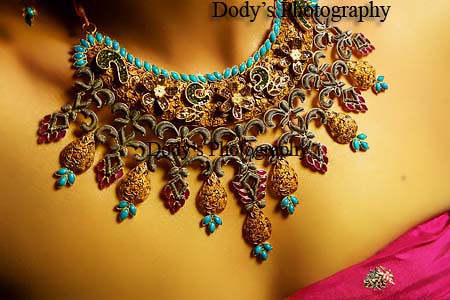SIC 5094
JEWELRY, WATCHES, PRECIOUS STONES,
AND PRECIOUS METALS
This industry classification comprises establishments involved
in the wholesale distribution of jewelry, watches, precious
stones, and precious metals.Products of the industry include
clocks, coins, gem stones, pearls, precious metals bullion,
silverware, and trophies. Establishments primarily engaged in
the wholesale distribution of precious metal ores are included
in SIC 5052: Coal and Other Minerals and Ores.
NAICS Code(s)
421940 (Jewelry, Watch, Precious Stone,
and Precious Metal Wholesalers)
Industry Snapshot
According to the U.S. Census Bureau, the jewelry, watch,
precious stone, and precious metal wholesalers represented
approximately 8,215 establishments. Combined, these
employed some 54,408 people with an annual payroll of
$2 billion. In 2003, the total number of establishments climbed
to 12,936. The industry generated approximately $13.8 billion
in annual sales. The total number of employees reached 61,411.
The average sales per establishment were $1.10 million.

The majority of the establishments were small—employing fewer
than five people. There were a total of 9,939 establishments
with fewer than five employees.
Jewelry, the largest sector of the industry, numbered 4,872
establishments and dominated more than 37 percent of the
market. Together, this group accounted for $4.8 billion in sales.

The jewelry and precious stones sector numbered 3,435
establishments and controlled more than 26 percent of the market.
Combined, this group generated $2.5 billion in sales. Diamonds
represented 1,327 establishments and controlled about ten
percent of the market, with $1.7 billion in sales. States with
the majority of establishments include New York with 2,981,
California with 2,685, and Texas with 1,143.

Background and Development
Jewelry is as universal and ancient a form of adornment as clothing.
It has been made of a variety of materials from human hair to
precious metals and gems, and has been used to signify
social status, wealth, official or political rank, holidays and
celebrations, and fad and fashion.

Its forms have included items
for the head (hairpins, headbands, crowns, earrings, and lip and
nose rings); neck (pendants and necklaces); chest (brooches,
cloak clasps, buttons); waist (belts and girdles); and arms and
legs (bracelets, anklets, and rings).

As an industry, jewelry has
been represented in all the major civilizations by goldsmiths,
metalworkers, gem cutters, and many others. The Byzantine
Empire (approximately the 6th to 13th centuries) with its profusion
of gold and enamel and the European Renaissance
(the 15th to 17th centuries) characterized by the use of
gemstone-emblazoned fabrics and chains, ropes, pendants,
and girdles were perhaps the greatest moments in
the history of jewelry.

Watches were developed around 1450-1500 when the coiled
spring made the invention of the pocket watch possible.
By the 17th century, crystal faces to protect the workings, bearings,
hairsprings, and balance wheels were standard. Watches were
handcrafted by skilled artisans until about 1800 when machine-made
parts led to mass production. Electric and electronic watches were
introduced in the 1950s and 1960s.

During the first few years of the 1990s, conditions within the jewelry,
watches, precious stones, and precious metals industry were
unstable. In 1993, the number of establishments was about
6,800 and sales were about $45 billion, which was up from
a 1990-91 low of about 6,000 establishments and $40 billion
in sales. High numbers of retailer bankruptcies, fluctuations
in international currency exchange rates, and the recession
in the United States and abroad led to reduced profitability
for wholesale dealers.

In January 1994, however, Jewelers' Circular-Key-stone
reported that conditions appeared to be improving. Some
diamond dealers attributed the turn-around to the repeal of
the federal luxury tax in 1993. During 1994, the heaviest
projected demand was for diamond jewelry, loose diamonds,
and karat gold jewelry.

Gem stones were also experiencing an upswing. Industry
forecasters expected growth in ruby, sapphire, emerald,
tourmaline, and tanzanite sales. The highest projected demand
was for stones in earth tones, such as orange and peach.
Pearl dealers also anticipated improving conditions.

Although high-quality Japanese pearls remained expensive
and in short supply, forecasters predicted that increased supplies
of Chinese freshwater pearls and South Sea pearls would help
bring prices down in the lower-quality sector of the pearl market.
This, coupled with increased demand, was expected to yield
higher net profits.

Watch suppliers also expected sales to increase slightly during
1994. Annual U.S. watch sales were pegged at 65 million units
with women's and jewelry watches, sport watches, upscale
watches, two-tone watches, stainless steel watches,
and watches with lighted dials remaining popular.

In the mid-1990s, jewelers were trying to lower their business
costs, increase productivity, and tighten their customer base to
increase profitability. The diamond trade was having especially
low confidence due to foreign competition.

The industry employed more than 50,000 and generated sales
of about $44 billion in 1998. Sales in jewelry stores increased
about 8.5 percent from 1997 to 1998 to $22 billion, and about 40
percent of sales occurred in the fourth quarter of 1998, in
keeping with traditional holiday sales trends. Other than jewelry
stores, gemstones, jewelry, precious metals, and watches are
sold by department stores, warehouse stores, home shopping
television, catalogs and showrooms, and over the Internet.
Over 28,000 jewelry stores across America accounted for
approximately half of the nation's jewelry sales in 1998.

Consolidation occurred as large chains purchased others,
and growth took place as these same chains expanded their
number of outlets in shopping malls. Zale Corporation acquired
Peoples Jewelers of Canada in June 1999, but Service
Merchandise (a major catalog showroom) filed for bankruptcy,
also in 1999; these events show that this industry is both highly
competitive and risky. Retailers have sought new ways of
improving product value. As a result, jewelry imports have
increased from 26 percent in 1983 to 52 percent in 1997.

With economic declines in Asia, Asian wholesalers have
turned to the United States and Europe with increased
volumes of exports.

Jewelers improved their prospects substantially in the late
1990s by better marketing and improved tracking of supplies,
demand, and sales; they also were able to capitalize on
simple demographics as the United States emerged from the
recession earlier in the decade with baby boomers reaching
their maximum earnings years and investing their income
in jewelry. The large jewelry chains were continuing to
consolidate into the 2000s, and retailers were optimistic
about trends and fashions in jewelry and watches and growth
of markets at a range of income levels.

Current Conditions
Jewelers credit the bridal business with 30 to 50 percent of
their revenue. Holidays and gift-giving opportunities, are also
major factors in sales of watches and jewelry. Year-round
spending and the growth of purchases among women of jewelry
for themselves have made jewelers less dependent on December
holiday sales, despite cyclic sales related to the economy and,
to a lesser degree, the seasons.

Jewelry sales also depend heavily on fashion trends. Colored
gemstones, designs from natures, diamonds in virtually any
form, yellow gold, white metals, princess-cut gemstones,
Tahitian pearls, and invisible necklaces are expected to be
among the most popular.
In precious metals, gold commodity prices have continued to
drop, but jewelry manufacturers and retailers have yet to
pass savings along in lower prices because, given the metal's
volatile price, they are protecting their ability to pay higher
prices for gold over the coming years. Forecasters expected
sales of silver jewelry and other white metals to remain strong,
with platinum is the strongest of the precious metals in sales.
China and Japan lead the world in consumption of platinum
jewelry.

Industry Leaders
The top 20 firms in jewelry sales consisted of about 50
percent jewelery specialists. Tiffany & Co., Whitehall Jewelers,
and the Piercing Pagoda were the only three companies with
both unit growth and sales that exceeded 20 percent. For
the industry as a whole, 1998 sales growth was 7 percent
(compared to 8.7 percent in 1997) and unit growth was 2.3
percent (3.8 percent in 1997). The two major television
shopping networks generated about 3 percent of industry-wide
sales in 1996 through 1998. Of the three corporate leaders,
Tiffany & Co. epitomized quality and name recognition worldwide;
in the second quarter of 1999, Tiffany's earnings increased 63
percent. Whitehall Jewellers, Inc., has 276 stores in 31 states
and has projected earnings growth rates of 30 percent and 22
percent for fiscal 1999 and 2000, respectively. Following a
massive reorganization in the late 1980s, Zale Corporation is
the largest specialty retailer (per 1999 statistics) with 1,300
stores in the United States, Canada, and Puerto Rico under
several firm names; they also have considerable direct mail
and online sales. The specialty jewelry market posted positive
results from 1998 through 2002, according to Jewelers'
Circular Keystone. Overall sales increased about 20 percent
over the five year period, falling only in 2001 to 2.2 percent.
Internet sales of jewelry and watches are anticipated to rise to
$56 million in 2000 and $140 million by 2001. Polygon Network,
Inc., maintains Web sites for approximately 3,000 retailers
and suppliers on six continents as well as providing online
information resources. The Network experiences daily
transactions of about $3 million and, as of 2000, holds
a loose diamond inventory valued at about $100 million.

Research and Technology
Sellers of diamonds are increasingly threatened by sales of
cubic zirconium and other, less expensive "diamond look-alikes".
The largest diamond marketer worldwide, De Beers, is
experimenting with "diamond branding" to mark the firm's name
and identification numbers on diamonds. Development of this
technique includes reader machines to detect the tiny, laser-cut
inscriptions. Production of synthetic gemstones continues to
be a strong research field.

De Beer's who had been in control of the synthetic diamond
market, had new rivals. Newly formed Apollo Diamond Inc.
located in Boston, Massachusetts, and Gemesis Corp. of
Sarasota, Florida had come up with a new technology for
producing manufactured synthetic diamonds within a lab.
De Beer's never dreamed the Russian technology would ever
be mastered. The actual manmade diamonds are created in
only a few days versus the natural diamonds that are mined
from under the earth.

used a process known as Chemical Vapor Deposition (CVD),
while Gemesis used a high—pressure,
high temperature technique that imitates the geologic conditions
under which natural diamonds are formed. The diamonds were
expected to be sold about 30 percent less than the price of
a natural diamond. Gemesis had sold its yellow synthetic
diamonds through retail jewelers at about 10 to 50 percent less
than the manmade diamonds. Gemesis was working on producing
various other colors, specifically blue, by late 2004.














No comments:
Post a Comment